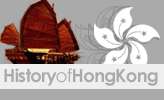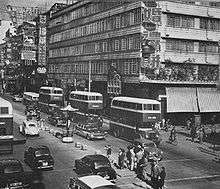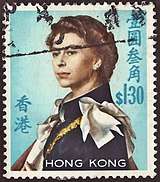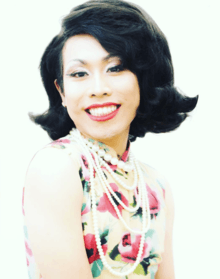1960s in Hong Kong
1960s in Hong Kong continued with the development and expansion of manufacturing that began in the previous decade. The economic progress made in the period would categorise Hong Kong as one of Four Asian Tigers along with Singapore, South Korea, and Taiwan.
| This article is part of a series on the |
| History of Hong Kong |
|---|
 |
| Timeline |
| By topic |
|
Background

Economically, this era is considered a major stepping stone for Hong Kong. It is considered the first turning point for Hong Kong's economy. The per capita GDP was still relatively low in 1960. It was approximately the same as Peru, South Africa and Greece in the same decade. By comparison, Argentina had two times and Venezuela had three times the GDP of Hong Kong.[1] The living standard was rising steadily, but low wages continued. The number of registered factories increased from 3,000 in 1950s to 10,000 in 1960s. Registered foreign companies increased from 300 to 500. There were demands for labour in every sector of the economy.

Politically, however, this era is marked by the political chaos in mainland China.
Demographics
Culture
Lifestyle
The past generations of Chinese families were deeply rooted in family affairs. The long hours in the factories would break apart that traditional structure when most people spend far more time working in factories than at home. But people lived under a strong willingness to bear sufferings. This was slightly compensated by their close relationship within the community, and cheerful talks in their spare times. Work places mainly served as educational hubs or the "second home". Women also joined the work force in larger numbers, becoming working daughters or working mothers.[3]
Education
The government pursued an ambitious public education programme, creating over 300,000 new primary school places between 1954 and 1961. By 1966, 99.8% of school-age children were attending primary school, though the primary schools were not free.[4]
Events
From 6 to 15 December 1969, the first Hong Kong Festival was launched after 7 months of preparation work with HKD $4 million of funding. It originated after the 1967 riots in hopes that people unleash their energy toward a better cause instead of communists' riots. The number of participants reached more than 500,000 including foreign tourists.
Entertainment


The 1960s cinema films were still rooted in a Chinese tradition, though Hong Kong would have one of their first pop culture teen idols, Connie Chan Po-chu. The arrival of broadcast television would become the first format brewed in Hong Kong to be marketed toward the people of Hong Kong directly. TVB station was founded in 1967 and made the first free-over-the-air broadcast.[5]
Law and order
The first disturbance in the 1960s was the Hong Kong 1966 riots over the rising fares of the Star Ferry. A petition was created with 20,000 signatures in protest against any increases in transportation costs. The result led to the arrest of 1,800 people, but the end came swiftly.
Other riots include the Hong Kong 1967 riots which began when internal conflict within the Communist party in China resulted in the Cultural Revolution. Pro-communist leftists in Hong Kong challenged British rule. Demonstrations were held, the red guards would take shape in Hong Kong carrying Quotations from Chairman Mao Zedong in their left hands shouting communist slogans. The People's Daily in Beijing ran editorials supporting the leftist struggle. Rumors spread that China was preparing to take over the colony. Political tension soared. The riots only came to an end in December 1967 when Chinese Premier Zhou Enlai ordered the leftist groups in Hong Kong to stop. After the riot, the government made an effort to clean up any existing communist networks. The radio host Lam Bun was also murdered.
Natural disasters
Drought
In 1963 and 1967, serious droughts affected Hong Kong. Water supply was unable to support the needs of the rapid population growth. The government introduced a water restriction policy. There were periods when water supply was restricted to 4 hours per 4 days. People had to save water for 4 days of usage. Water shortages, however, were mainly created by the politics (see resource section).
Typhoon
In 1960, Typhoon Mary affected Hong Kong, causing 45 deaths and 127 injuries. It also destroyed about 10,000 homes.
In 1962, Typhoon Wanda affected Hong Kong, causing 130 deaths. 72,000 people left homeless. It was one of the most disastrous typhoons to ever affect Hong Kong.
Economy

Construction
The construction business would also continue to increase along with the demand of highways, buildings, tunnels, and reservoirs. In 1962, the director of public works questioned where to go after the development of Kwai Chung and Tsuen Wan. The construction expansion went west to Tuen Mun and north to Sha Tin. The first post-World War II documentation to provide detailed information about the territory came in 1969 in a guide titled the "Colony Outline Plan". It was the first paperwork to outline strategies to house a million people with low-cost public housing, along with defining tight regulations and guidelines on how to construct among the high density population.[6]
Manufacture
While many companies were beginning to diversify in the products it manufactures, the entire success of the Hong Kong colony rested on the textile industry. An estimated 625,000 residents were supported directly or indirectly by this one industry. The government was depending on its Shanghai entrepreneurs and the industry collectively ran in 3 shifts around the clock. It was from this point that the cheap low-grade products became high-quality products with the "Made in Hong Kong" label.[6] By 1968, factories employing fewer than 100 workers accounted for 42 percent of Hong Kong's domestic exports to the UK, amounting to HKD $1.2 billion.[4]
Hospital and hospitality
From 1960 to 1965, the executive council tried to revamp the medical system to provide some form of low cost health care directly or indirectly to large sections of the population. Staff at the medical and health departments were outlining proposals to estimate demands for the next 15 years. The Hong Kong Flu of 1968 would infect 15% of the population.[7]
During the beginning of the Vietnam War, the U.S. made Hong Kong a frequent stop for resting troops in the Asian region. It was considered one of the neutral zones not affected by the communists despite all the political riots taking place.
Resource
The main source of water in Hong Kong was China. A contract was signed in 1964 when Hong Kong purchased 15,000 gallons of water a day drawn from China's East river.[8] When political turmoil came to Hong Kong, China turned off the supply periodically and caused water shortages. Rationing was imposed by the government.
References
- Dorn, James A. [1998] (1998). China in the New Millennium: Market Reforms and Social Development. Cato Institute. ISBN 1-882577-61-2
- Manion, Melanie. [2004](2004). Corruption by Design: Building Clean Government in Mainland China and Hong Kong. Harvard University press. ISBN 0-674-01486-3
- Salaff, Janet W. [1995] (1995) Working Daughters of Hong Kong: Filial Piety Or Power in the Family. Columbia University. ISBN 0-231-10225-9
- EhNet. "EhNet Archived 13 February 2007 at the Wayback Machine." "Hong Kong article." Retrieved 20 February 2007.
- Ma, Eric Kit-wai. Ma, Chieh-Wei. [1999] (1999). Culture, Politics, and Television in Hong Kong. United Kingdom: Routledge. ISBN 0-415-17998-X
- Buckley, Roger. [1997] (1997). Hong Kong: The Road to 1997 By Roger Buckley. Cambridge University Press. ISBN 0-521-46979-1
- Starling, Arthur. [2006] (2006) Plague, SARS, and the Story of Medicine in Hong Kong. HK University Press. ISBN 962-209-805-3
- Wiltshire, Trea. [First published 1987] (republished & reduced 2003). Old Hong Kong - Volume Three. Central, Hong Kong: Text Form Asia books Ltd. Page 5. ISBN Volume Three 962-7283-61-4
| Wikimedia Commons has media related to Hong Kong in the 1960s. |